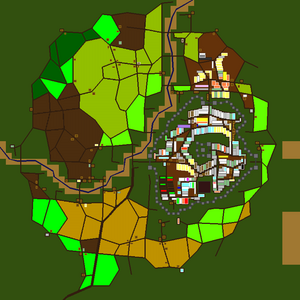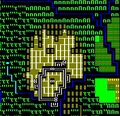- v50 information can now be added to pages in the main namespace. v0.47 information can still be found in the DF2014 namespace. See here for more details on the new versioning policy.
- Use this page to report any issues related to the migration.
Difference between revisions of "Town"
m (→Destroyed or abandoned towns: apostrophe shenanigans,etc) |
|||
| Line 129: | Line 129: | ||
== Destroyed or abandoned towns == | == Destroyed or abandoned towns == | ||
:''Further information: [[Ruin]]'' | :''Further information: [[Ruin]]'' | ||
| − | [[File:Destroyed.jpg|thumb|center|1000px| | + | [[File:Destroyed.jpg|thumb|center|1000px|Legends mode entry about a town being sacked]] |
In time, whether by war, beasts, a genocidal adventurer, or some other disaster, towns will be brought to ruin. Ruined towns are typically desolate wastelands of abandoned and destroyed buildings and structures. Shops and markets are typically bare, but occasionally some goods can still be left for you to steal. [[Bandit]]s and criminals may still lurk in the streets, and some may even make the ruins their home, if some supernatural creature or monster hasn't made themselves cozy already. | In time, whether by war, beasts, a genocidal adventurer, or some other disaster, towns will be brought to ruin. Ruined towns are typically desolate wastelands of abandoned and destroyed buildings and structures. Shops and markets are typically bare, but occasionally some goods can still be left for you to steal. [[Bandit]]s and criminals may still lurk in the streets, and some may even make the ruins their home, if some supernatural creature or monster hasn't made themselves cozy already. | ||
Revision as of 15:09, 25 March 2022
v52.04 · v0.47.05 This article is about the current version of DF.Note that some content may still need to be updated. |
- "Town" may also refer to a fortress that has reached a certain population level.

Places of interest:
▊ Castle Tower
█ Castle Wall
█ Castle Wall Walkway
█ Warehouse
█ Dormitory
█ Dining Hall
█ General Import Market
█ Food Import Market
█ Clothing Import Market
█ Meat Market
█ Edible Produce Market
█ Cheese Market
█ Edible Processed Plants Market
█ General Import Store
█ Food Import Store
█ Clothing Import Store
█ Cloth Shop
█ Tanning Shop
█ Cloth Clothing Shop
█ Leather Clothing Shop
█ Bone Carver Shop
█ Gem Cutter Shop
█ Metal Weapons Shop
█ Wood Weapons Shop
█ Blacksmith Shop
█ Armorsmith Shop
█ Metal Crafter Shop
█ Leather Accessories Shop
█ Wooden Furniture Shop
█ Stone Furniture Shop
█ Metal Furniture Shop
█ Fortress
█ Underground Farming
█ Underground Industrial
█ Underground Living
█ Underground Guilds
█ Underground Merchants
█ Trenches
█ Tavern
█ Well
█ House
█ Cottage Plot
█ Mead Hall
█ Temple
█ Library
█ Shrine
█ Crops 1
█ Crops 2
█ Crops 3
█ Meadow
█ Pasture
█ Orchard
█ Woodland
█ Waste
█ Town Yards
█ Abandoned
█ Ruin
█ Unknown
A town is a large site founded and inhabited by humans and, possibly, various other creatures. The population and size can be determined by the map symbol representing it; from least to most populous: +, *, #, and ☼. All towns start out from hamlets, which immediately form into towns under the right circumstances, during worldgen. Roads link towns between other nearby towns and dwarven fortresses, as well as sites conquered by humans.
The population for each level of town is:
- + : 0 - 1000
- * : 1000 - 2000
- # : 2000 - 8700
- ☼ : +8700
Adventurers spend much quality time in towns - they can come to trade, speak, or entertain the townspeople, and occasionally to slay those who have invited their wrath. Taverns in towns are a popular destination for many adventurers; they are the only sources of alcohol in human settlements and provide excellent entertainment, which includes performances and the occasional drunken brawl. Other people of interest include:
- mercenaries, who will gather at taverns, and make for great traveling companions.
- criminals, who may be the target of quests
- priests and monks, craftsmen, and merchants, who may have traveled the world, and may be embroiled in all sorts of intrigue.
Keep
At the heart of a town is a walled stronghold, garrisoned by many soldiers. Inside of the keep can be found a lord or lady, other high nobility, and men-at-arms willing to follow you unto death. If the town is the civ's seat of power, then the law-maker will also reside here. Below almost every keep is a dungeon.
Since .47.01, keeps have had their households expanded, and most human keeps will have a variety of members, some familiar from fort mode, like doctors and executioners, some related to the expanded city, like judges, fire commissioners and sewer administrators, and some just plain household, like the housekeepers and chefs. The vast majority of these don't have interesting game mechanics associated with them tied to their positions, but many of them are caught up in some scheme.
The town proper
Outside of the keep is the realm of the bourgeoisie. Commuters and travelers walk among the densely-packed houses and shops in narrow streets, while stray domesticated animals roam the muddy alleyways and pastures. Vast shopping districts are major trade centers. Other buildings include warehouses (which can be ransacked without repercussion) and wells. Common structures include taverns and temples, but libraries are very rare.
Below is a list of different shops and markets found in a town. Most towns do not have every single retail good available, and adventurers may have to travel to a different town in order to browse wares of a particular type. The shops that are "common" are common because only animal products (meat, bone, leather) and farm products (cloth and food) are produced in any significant numbers. Stone, wood, and metal are all extremely rare materials in towns, and because of this, few industries based upon these materials will spring up. An exception is the leather goods shop, which is rare compared to other leather shops.
Common shops:
- µ General imports
- % Food imports
- [ Clothing imports
- [ Woven clothing shop
- º Cloth shop
- [ Leather clothing shop
- ß Leather shop
- Å Bone carver's shop
Rare shops:
- ╤ Carpenter's shop
- ╤ Stone furniture shop
- ╤ Metal furniture shop
- ♦ Gem cutter's shop
- [ Armorsmith's shop
- / Bowyer's shop
- / Weaponsmith's shop
- Å Leather goods shop
- Å Metal craft shop
In a market, one can find:
Subterranea
Below a town are several subterranean structures: dungeons, catacombs, and sewers. All three can be present at once, and frequently connect and overlap each other. Tombs may also be present alongside catacombs. Criminals, outcasts of society and various subterranean creatures hide in the dark passages. They are common destinations for those looking to finish a quest, gain reputation, or search for valuable loot.
Dungeons reside below the keep, while catacombs reside below temples. Both buildings are almost always present - sewers, on the other hand, can only be found in more developed towns. The presence of a sewer in a town can be confirmed by the presence of floor grates in the middle of streets – accessible via small and elusive entrances above-ground, or by diving below nearby waterways.
Destroyed or abandoned towns
- Further information: Ruin
In time, whether by war, beasts, a genocidal adventurer, or some other disaster, towns will be brought to ruin. Ruined towns are typically desolate wastelands of abandoned and destroyed buildings and structures. Shops and markets are typically bare, but occasionally some goods can still be left for you to steal. Bandits and criminals may still lurk in the streets, and some may even make the ruins their home, if some supernatural creature or monster hasn't made themselves cozy already.
Gallery
"Town" in other Languages
|
Worlds | |||||||||
|---|---|---|---|---|---|---|---|---|---|
| General | |||||||||
| Map |
| ||||||||
| Civilization |
| ||||||||





